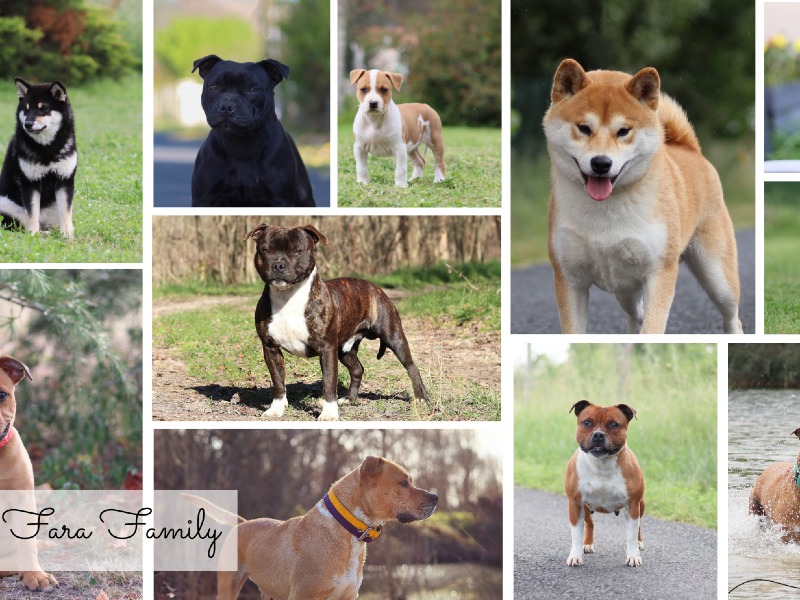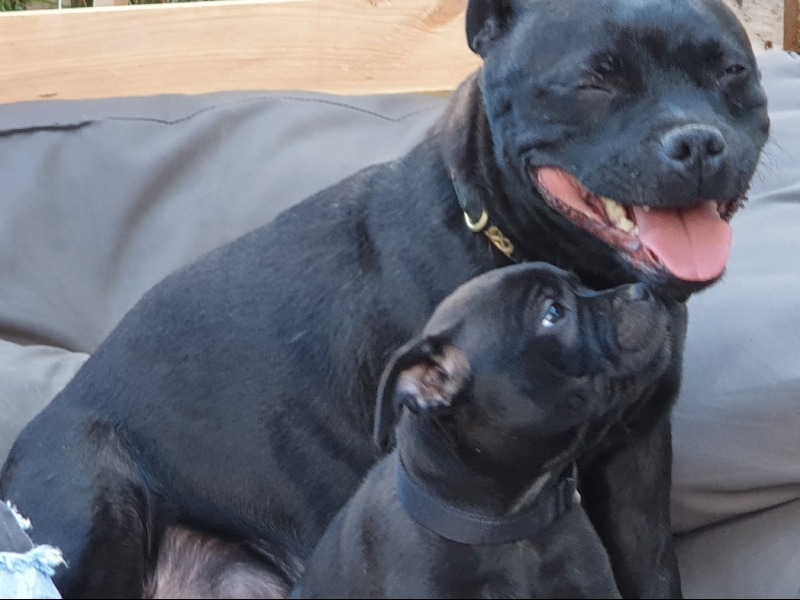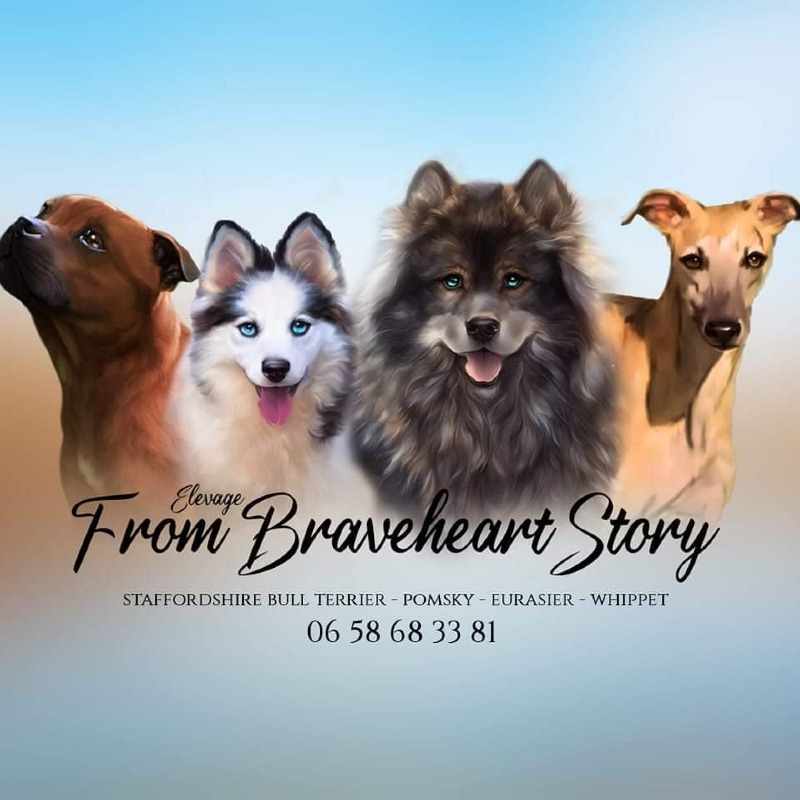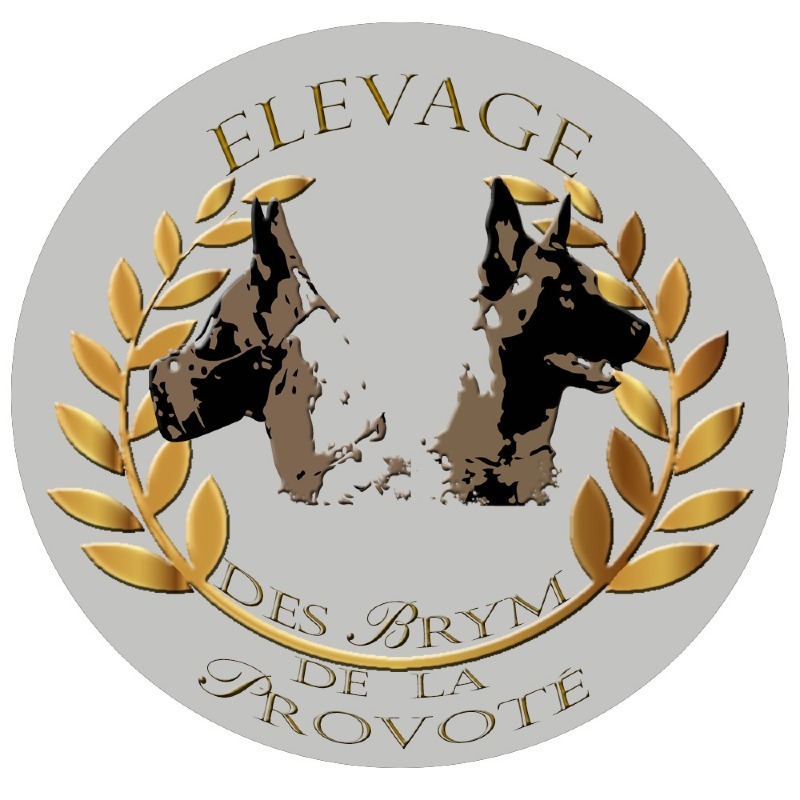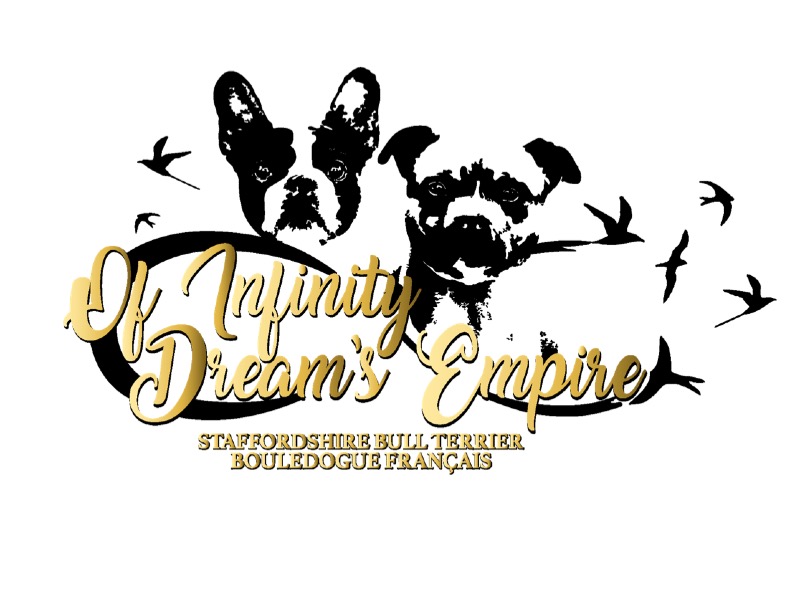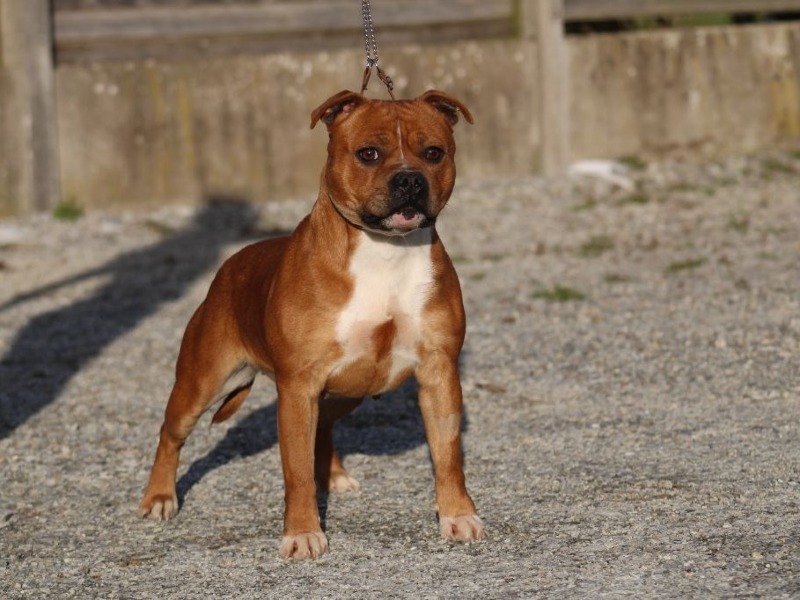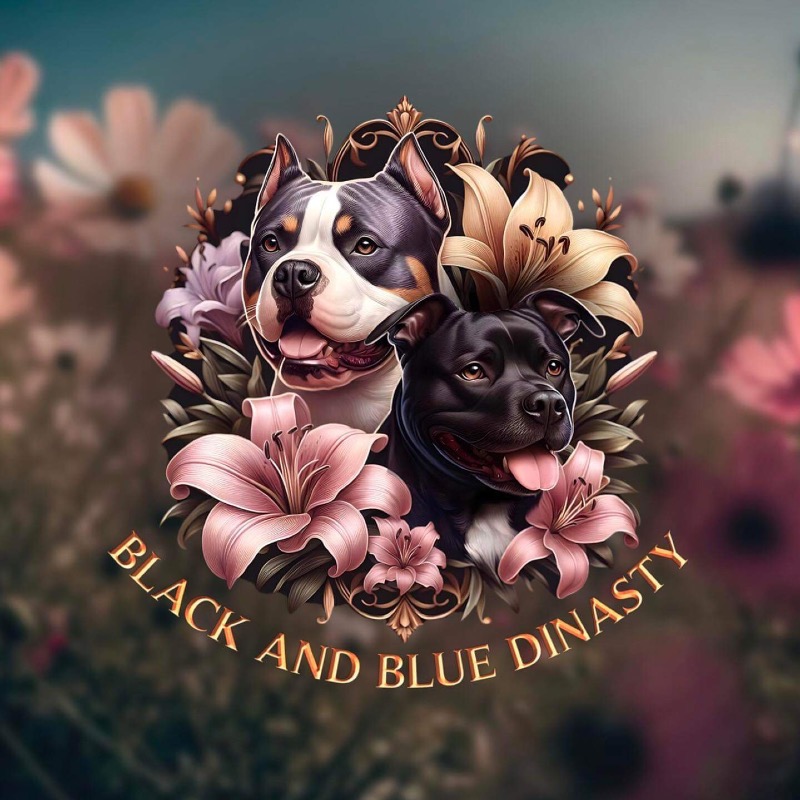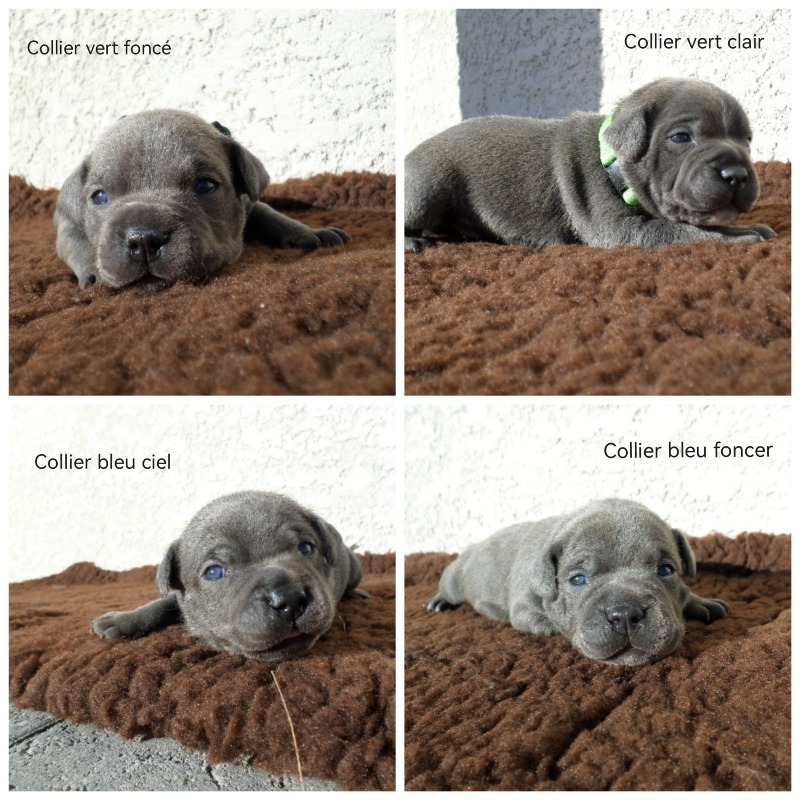Staffordshire bull terrier
Welcome to our page dedicated to the breed of dog staffordshire bull terrier!
Here, you will find all the useful information about staffordshire bull terrier. This descriptive profile will allow you to discover the aspects of this breed. You can notably consult information about the average price, monthly and annual upkeep expenses, their health, name ideas, as well as their official recognition by competent authorities.
Explore this page to discover everything you need to know.
Overall description of the breed
The Staffordshire Bull Terrier, a wholly British breed, emerged in the 19th century, primarily as a bull-baiting and animal-fighting dog, pitted against animals larger than itself. This sporting practice was banned in the United Kingdom as early as 1837.
Derived from a crossbreeding between the Old English Bulldog and English terrier breeds such as the Manchester Terrier or the White Terrier, the Staffordshire Bull Terrier embodies a perfect blend of bloodlines, influenced by various bulldog-type breeds that lend it thickness and the terrier type that imparts an athletic morphological structure.
Since the beginning of the 20th century, meticulous selection has largely eradicated the aggressive temperament and combat instinct of the Staffie, with the aim of transforming it into an ideal domestic companion. The Kennel Club recognized it as early as 1935 and officially christened it the Staffordshire Bull Terrier. The International Canine Federation definitively registered it on October 21, 1954. Its current standard, published on June 26, 1987, is still in force.
Of medium size, the Staffie possesses exceptional physical robustness, with a well-developed muscular structure while maintaining remarkable agility and flexibility. Its body is harmoniously proportioned, balanced, and homogeneous, being as tall as it is long, thus creating a square silhouette. Stocky and compact, it exudes great power due to its thick bone structure, ample chest, pronounced musculature, and massive head.
Its domed skull and sturdy jaws, accompanied by a pronounced central furrow, give its head an imposing presence. A distinct stop and large, round, bright eyes give it a mischievous and lively expression. The ears, rather small, are fine and well-proportioned, carried in a half-rose position on the sides of the skull. Its tail, thick at the base, gradually tapers towards the tip, reaching the hock and following the line of its back.
The coat of the Staffordshire Bull Terrier is short, dense, and silky. Colors accepted according to the standard include red, fawn, white, black, or blue, or any combination of these colors with white. All shades of brindle, with or without white, are also permitted.
The temperament of the Staffordshire Bull Terrier is gentle, affectionate, and tender towards members of its social group. It becomes so attached to its owners that intense bonds can form, sometimes leading to hyper-attachment. It is an enduring and vigorous dog that requires regular activities to expend its energy. Play sessions and intense efforts will contribute to its well-being.
For its complete development, the Staffie requires strict training and a structured environment. In the absence of authority, its stubborn and determined nature could lead to disobedient behavior. Being particularly dynamic, it is advisable to socialize it from a young age and not encourage its fighting instinct. When its energy is channeled correctly, it remains calm and balanced.
The Staffordshire Bull Terrier is an extremely popular breed, offering faithful and endearing companionship on a daily basis. It brings great joy to many families across Europe and around the world.
Adult: The Staffordshire Bull Terrier will weigh from 12.7 to 17 kg (28 to 38 lbs) for males and from 11 to 15.4 kg (24 to 34 lbs) for females. Its height at the withers will range from 35.5 to 40.5 cm (14" to 16").
Awareness of acquiring an animal
Each animal is a sensitive being, deserving love, attention and care.
When you choose to adopt an animal, you take on the responsibility of ensuring its health and well-being throughout its life.
To learn more about animal welfare, we invite you to consult our FAQ by clicking the button below:
Origins
The Staffordshire Bull Terrier, often nicknamed Staffie, originates from England, in the county of Staffordshire, in the early 19th century. It is the result of crossings between Bulldogs and Terriers, aiming to create a robust and courageous dog, mainly used for dog fights and rat hunting. With the ban on dog fighting in the UK in 1835, the Staffordshire Bull Terrier gradually evolved to become a popular companion dog known for its loyalty and affection. Although its origins are marked by violent activities, this breed has been recognized for its gentle and friendly nature towards humans, especially children.
History
The history of the Staffordshire Bull Terrier begins in the early 19th century in England, at a time when dog fighting was a popular activity. Breeders sought to create a dog that was strong and agile, capable of competing in the fighting arenas. By crossing Bulldogs with local Terriers, they developed the Staffordshire Bull Terrier, a breed that combined the tenacity of the Terrier with the power and courage of the Bulldog. With the ban on dog fighting in 1835, Staffies' owners began to appreciate their qualities as a companion dog. In 1935, the breed was officially recognized by the British Kennel Club, and since then, it has become a beloved companion for its loyalty, courage, and affection.
Standard
The standard of the Staffordshire Bull Terrier breed, as defined by the Fédération Cynologique Internationale (FCI) and the Kennel Club of the United Kingdom, describes a medium-sized dog, compact, well-proportioned, and muscular. The head is short and deep, with a wide skull and well-developed cheek muscles. The eyes are round, medium-sized, and dark in color, showing an intelligent and lively expression. The ears are rose or semi-erect. The muzzle is short with powerful jaws and a black nose. The neck is short and muscular, widening towards well-placed shoulders. The coat is short, smooth, and tight. Accepted colors include red, fawn, white, black, blue, or any combination of these colors, including brindle.
Physical characteristics
The Staffordshire Bull Terrier is a medium-sized dog, generally measuring between 35 and 40 cm at the withers and weighing between 11 and 17 kg. Its build is compact and muscular, with a strong bone structure and a robust appearance. The head is wide and short, with powerful jaws and a short muzzle. The eyes are round and expressive, often dark in color. The ears are small and semi-pricked or rose. The coat is short, smooth, and dense, offering a tidy and easy-to-maintain appearance. Coat colors vary, including red, fawn, white, black, blue, and any combination of these colors, including brindle. The tail is of medium length, tapering towards the tip and carried low.
Character
The Staffordshire Bull Terrier is known for its affectionate, loyal, and courageous character. Despite being a powerful and energetic dog, it is extremely gentle and patient, especially with children, earning it the nickname "Nanny Dog" in the UK. It is sociable and enjoys spending time with its family, demonstrating great loyalty and a desire to please. The Staffie is also intelligent and curious, making it responsive to training and stimulating activities. However, it can be stubborn, requiring firm but gentle training. Its protective nature makes it an excellent guard dog, but it is not naturally aggressive towards humans, instead showing reserve towards strangers.
Life expectancy
The Staffordshire Bull Terrier enjoys a relatively long life expectancy for a dog of its size, typically between 12 and 14 years. This longevity is the result of its natural robustness and low genetic predispositions to certain diseases. To maximize their life expectancy, it is essential to provide them with balanced nutrition, regular veterinary care, and appropriate physical activity. Owners must also monitor for signs of common diseases in this breed, such as skin problems, eye diseases, and joint conditions. Regular veterinary check-ups help to quickly detect and treat any health conditions, thus contributing to a long and healthy life for the Staffordshire Bull Terrier.
Exercise and activity needs
The Staffordshire Bull Terrier is an energetic and active breed that requires a significant amount of exercise to stay healthy and happy. On average, they need at least one to one and a half hours of daily exercise, which can include walks, runs, fetch games, and interactive play sessions. Staffies also enjoy mental challenges, such as dog puzzles and obedience training, which help stimulate their sharp minds. This breed is well-suited for intense physical activities and enjoys canine sports like agility and flyball. Regular exercise helps prevent boredom and destructive behaviors, ensuring a balanced and content dog.
Recommended diet
The Staffordshire Bull Terrier's diet should be balanced and adapted to their high energy needs. A high-quality diet, rich in proteins and essential nutrients, is recommended. Premium kibbles specifically formulated for active breeds are ideal. An adult Staffie consumes on average between 200 and 400 grams of dry food per day, divided into two meals. The monthly cost of food varies between 30 and 60 euros, depending on the quality of the products chosen. It is crucial to monitor their weight and avoid overeating, as obesity can lead to various health problems. Treats can be used in moderation for training, but should be taken into account in the daily calorie total.
Training and obedience
Staffordshire Bull Terrier training and education require a firm yet gentle approach, as this breed is both intelligent and sometimes stubborn. Starting training at a young age is essential to establish good habits and proper socialization. Positive reinforcement methods, such as treats and praise, are particularly effective with this breed. Consistency and patience are the keys to success. Staffies respond well to basic commands like "sit," "come," "heel," and "stay." Early socialization with other dogs and various environments helps prevent unwanted behaviors. Obedience classes and activities like agility can also be beneficial for stimulating their active minds and strengthening the bond with their owner.
Behavior with children
The Staffordshire Bull Terrier is often considered an excellent companion for children due to its affectionate, patient, and protective nature. It is known for its tolerance and gentleness, often earning the nickname "Nanny Dog" in the UK. Staffies are very sociable and enjoy participating in children's games, demonstrating great loyalty and a desire to please. However, due to their energy and strength, it is important to supervise interactions between young children and the dog to avoid unintentional accidents. Teaching children to respect the dog and interact with it appropriately is essential for a harmonious cohabitation. With proper socialization and adequate supervision, the Staffordshire Bull Terrier can be a loving and protective companion for children.
Compatibility with Other Animals
The Staffordshire Bull Terrier can live with other pets, but it often requires early socialization and gradual introduction. While they are naturally friendly and playful, some Staffies may show dominance or territorial instincts, especially towards other dogs of the same sex. It is important to monitor initial interactions and encourage positive experiences to establish a harmonious cohabitation. With cats and small animals, a slow and supervised introduction is essential to avoid predatory behaviors. In general, well-socialized Staffies from a young age get along well with other animals and can become loyal and protective companions in a multi-pet household.
Grooming needs
The Staffordshire Bull Terrier has a short and smooth coat that requires relatively little grooming. A weekly brushing is sufficient to remove dead hair and keep the coat shiny. Baths are only necessary occasionally, or when the dog is particularly dirty, using a gentle shampoo suitable for dogs. Ears should be checked and cleaned regularly to prevent infections, and teeth should be brushed frequently to prevent dental problems. Nails should be trimmed regularly to prevent injuries. Regular grooming helps to quickly detect skin problems or other abnormalities, thereby contributing to the overall health and well-being of the Staffordshire Bull Terrier.
Health
The Staffordshire Bull Terrier is generally healthy, but like all breeds, it can be prone to certain health issues. Common conditions include hip dysplasia, hereditary cataracts, and skin conditions such as atopic dermatitis. Staffies may also be predisposed to dental problems, requiring regular oral hygiene. It is crucial to choose a reputable breeder who tests their dogs for these conditions to minimize risks. A balanced diet, regular exercise, and routine veterinary visits are essential for maintaining their health. With proper care, the Staffordshire Bull Terrier can live a long and healthy life, with an average lifespan of 12 to 14 years.
Average price
The price of a Staffordshire Bull Terrier can vary significantly depending on several factors, such as lineage, pedigree, breeder reputation, and geographic location. Generally, the average price for a Staffordshire Bull Terrier puppy is between 800 and 1,500 euros. Specimens from champion bloodlines or with exceptional characteristics can cost much more, sometimes up to 2,500 euros or more. It is essential to choose a reputable breeder who adheres to health and animal welfare standards. Although this may mean paying a higher price, it often ensures a healthy and well-socialized puppy. Prospective owners should also budget for additional expenses for veterinary care, food, accessories, and training.
Expenses
Monthly expenses for a Staffordshire Bull Terrier can vary depending on several factors, including food, veterinary care, grooming, and accessories. On average, owners can expect to spend between 60 and 100 euros per month. Quality food, tailored to the specific needs of the breed, costs approximately 30 to 50 euros per month. Regular veterinary care, including vaccinations and parasite treatment, can add 10 to 20 euros per month. Grooming, although minimal, can cost 10 to 20 euros per month if done by a professional. Toys, treats, and other accessories can add an additional 10 to 20 euros. These costs can vary depending on the specific needs of each dog and the owner's choices.
Name ideas
Choosing a name for your Staffordshire Bull Terrier can be a fun and exciting task. Here are some name suggestions that could suit the personality and robust appearance of this breed: Rocky, Bella, Max, Luna, Zeus, Daisy, Charlie, Maya, Rex, Ruby, Thor, Nala, Bruno, Athena, Oscar, Zara, Milo, Sadie, Ginger, Toby. When choosing a name, it is important to consider its pronunciation and ensure that it does not sound too much like basic commands to avoid any confusion during training. Take the time to observe your dog and choose a name that reflects its unique personality and strong, lovable appearance.
Legislation and regulation
In France, the Staffordshire Bull Terrier is not classified as a dangerous breed of dog and is therefore not subject to specific restrictions. However, it is essential to comply with general regulations regarding dog ownership, including identification by microchip or tattoo, and up-to-date vaccination. Owners must also take out public liability insurance to cover any potential damage caused by their dog. When traveling abroad, it is crucial to check the specific requirements of the destination country regarding health certificates and vaccinations. Always inquire about local and national laws to avoid any legal issues and ensure a harmonious coexistence with the Staffordshire Bull Terrier.
Official recognition
The Staffordshire Bull Terrier is recognized by several cynological organizations around the world. In France, it is recognized by the Société Centrale Canine (SCC). Internationally, it is recognized by the Fédération Cynologique Internationale (FCI), the Kennel Club (KC) in the UK, and the American Kennel Club (AKC) in the United States. These organizations define the breed standards and organize dog shows where Staffordshire Bull Terriers can be presented and evaluated. Recognition by these organizations also ensures that breeders adhere to health, temperament, and conformation standards, contributing to the preservation and improvement of the breed. Pedigrees issued by these organizations guarantee the purity and quality of the bloodlines.
Pedigrees
Staffordshire Bull Terriers can obtain pedigrees recognized by various breed clubs around the world, ensuring their pure lineage and adherence to breed standards. In France, the Société Centrale Canine (SCC) issues pedigrees. In the United States, the American Kennel Club (AKC) offers pedigrees for Staffordshire Bull Terriers. In the UK, the Kennel Club (KC) also issues pedigrees for this breed. Other organizations like the Fédération Cynologique Internationale (FCI) and the United Kennel Club (UKC) recognize and issue pedigrees for Staffordshire Bull Terriers. These organizations verify the dogs' origins and certify that they meet the breed's criteria, ensuring the quality and purity of the bloodlines.
Destination and usage
The Staffordshire Bull Terrier is mainly bred as a companion dog, thanks to its affectionate, loyal and sociable nature. Due to its protective nature and courage, it also makes an excellent guard dog. This breed is appreciated for its ability to adapt to various environments, whether in the city or in the countryside. The Staffordshire Bull Terrier excels in canine sports such as agility, obedience and flyball, thanks to its agility, intelligence and boundless energy. Its playful nature and patience make it an excellent companion for families, and it is often used in animal therapy roles due to its gentleness and ability to provide comfort.
Prohibitions
In France, the Staffordshire Bull Terrier is not part of the dog breeds subject to specific prohibitions or classified as dangerous. However, it is crucial to respect general regulations regarding the ownership of dogs, especially concerning identification, vaccination, and compliance with local laws regarding pets. In other countries, regulations may vary. For example, some regions may impose restrictions on the possession of bull-type breeds or specific requirements for owners. It is always important to inquire about local and national laws, especially when traveling or moving, to avoid any infringement and ensure a harmonious and legal coexistence with your Staffordshire Bull Terrier.
Breeders of Staffordshire bull terrier
Want to see more breeders of Staffordshire bull terrier?
Check out the page of our directory listing all breeders of Staffordshire bull terrierClassified Ads of Staffordshire bull terrier
Want to see more ads of Staffordshire bull terrier?
Check out the page listing all the ads of Staffordshire bull terrierBreed clubs of staffordshire bull terrier
No of staffordshire bull terrier breed clubs are currently registered on Preeders.
If you would like to highlight your breed club, sign up for free now and be the first to appear on this page.

